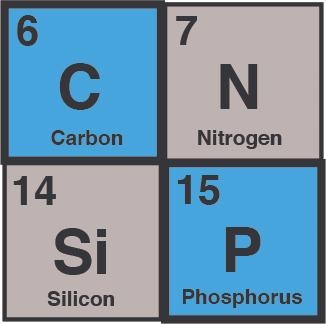The arrangement of the elements on the periodic table is done in a way to highlight specific relationships. There are families, groups (the vertical columns) and periods (the horizontal rows). The elements within each of these alliances display certain commonalities.
 This diagonal relationship between phosphorus and carbon has set the expectation that the diphosphorus molecule should mimic the attributes of the hydrocarbon acetylene. Image Credit: Figueroa Lab Group, UC San Diego.
This diagonal relationship between phosphorus and carbon has set the expectation that the diphosphorus molecule should mimic the attributes of the hydrocarbon acetylene. Image Credit: Figueroa Lab Group, UC San Diego.
In the periodic table, diagonal relationships are present between two elements in diagonal locations to each other who display similar chemical compositions. Boron and silicon, lithium and magnesium and phosphorus and carbon are all examples.
An important diagonal relationship has long been identified between phosphorus and carbon, particularly in scenarios where element-element multiple bonding exists, for example, diphosphorus (P2) wherein two phosphorus atoms are combined by a weak triple bond.
This diagonal association between carbon and phosphorus has set the anticipation that the diphosphorus molecule should imitate the features of the hydrocarbon acetylene (C2H2). For example, both acetylene and diphosphorus react with other organic molecules via their pi-bonds, a kind of covalent bond present in molecules possessing multiple bonding.
A coordination complex contains a central ion or atom that is typically metallic and is bordered by bound ions or molecules, called complexing agents or ligands. Coordination complexes are essential to life on earth and comprise chlorophyll and hemoglobin. They are also widely employed in industrial applications as catalysts.
While acetylene has precise coordination chemistry with single transition metals, coordination complexes that comprise diphosphorus bound to a single metal center have stayed indefinable.
Recently scientists at the University of California San Diego, the Ohio State University and the University of Rochester have been able to bind diphosphorus to a single metal center. Their work appears in the journal Science in the March 25th issue.
Diphosphorus—in contrast to acetylene—is very reactive and unstable. When produced in free form, diphosphorus quickly reacts or polymerizes with substrate molecules. Simply put, diphosphorus does not stay diphosphorus for very long—it is in its nature to join with other molecules and elements. This makes it challenging to analyze or control.
Numerous synthetic pathways have been set up to develop multinuclear diphosphorus complexes. The most common technique is by separating the tetrahedral P4 molecule, more frequently called white phosphorus. But, white phosphorus is lethal and extremely flammable (it was a key component in many inflammable bombs employed in World War II).
The work presented here provides a synthetic strategy to access mononuclear complexes of diphosphorus in laboratory settings. We anticipate that this coordination mode may further enable the development of selective phosphorus-atom transfer reactions to organic molecules.
Professor Joshua Figueroa, Principal Investigator and Study Co-Author, Department of Chemistry and Biochemistry, UC San Diego
In preparing the experiment, Figueroa and UC San Diego postdoctoral scholar Shuai Wang made use of iron as the metal ion as it offered a good coordination base that efficiently enabled the binding of small molecules.
By binding diphosphorus to an iron ion, they could combine together the two phosphorus atoms in a way that avoided the free release of diphosphorus, delivering the highly preferred stability.
Considering the extreme sensitivity of the free diphosphorus molecule as a fleeting species, it is remarkable how stable it becomes upon coordinating to the sterically encumbered mononuclear iron center.
Shuai Wang, Study First Author and Postdoctoral Scholar, UC San Diego
Wang conducted the synthetic work.
Scientists employed X-Ray crystallography to establish the exact 3D structure of the molecules and Mossbauer spectroscopy to note variations in the bonding interactions between the diphosphorus and the iron ion. This was an important method because it allowed the scientists to demonstrate that diphosphorus and an acetylene molecule affected the composition of the iron center in quite similar ways.
If diphosphorus can be found in a form that is comparatively stable and selectively reactive, researchers can attach it to substrates in something called “click” chemistry. Click chemistry does not define one single, specific reaction, but illustrates a method of producing substances by combining small modular units. This may pave the way for new avenues of discovery in synthetic chemistry for the making of pharmaceutical compounds.
We are excited about this work because it demonstrates the importance of using fundamental concepts learned in first-year chemistry in guiding new discoveries.
Professor Joshua Figueroa, Principal Investigator and Study Co-Author, Department of Chemistry and Biochemistry, UC San Diego
This study received support from the National Science Foundation through grants CHE-1802646 (to J.S.F.) and CHE-1954480 (to M.L.N.), as well as the National Institutes of Health through grant R01GM111480 (to M.L.N.).
Journal Reference:
Wang, S., et al. (2022) Side-on coordination of diphosphorus to a mononuclear iron center. Science. doi.org/10.1126/science.abn7100.